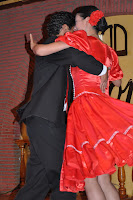We were looking forward to the folk night performance, bearing in mind the fact that the varied music and dance play an important role in the life of Peruvians. We had no idea what to expect as far as traditional dances were concerned once we knew that many of those were normally performed at religious ceremonies and would not necessarily be accounted for in that night's performance.
We were taken into the restaurant by Enrique, the agency's representative, who unexpectedly decided to bring onto the table a roasted guinea pig, which he insisted we should try when the buffet dinner was "officially" open.
We were amongst the first guests to arrive,which allowed us to have a table fairly close to the stage, but the whole thing would change the moment the room filled with people of all nationalities, mostly Japanese and people started moving about in front and around the stage.
I had a certain difficulty to handle both the photographing and filming simultaneously and from a certain moment into the performance started getting less accurate as to what I was exactly "capturing" in my sequence of images.
We were taken into the restaurant by Enrique, the agency's representative, who unexpectedly decided to bring onto the table a roasted guinea pig, which he insisted we should try when the buffet dinner was "officially" open.
We were amongst the first guests to arrive,which allowed us to have a table fairly close to the stage, but the whole thing would change the moment the room filled with people of all nationalities, mostly Japanese and people started moving about in front and around the stage.
I had a certain difficulty to handle both the photographing and filming simultaneously and from a certain moment into the performance started getting less accurate as to what I was exactly "capturing" in my sequence of images.


The opening group was very good, particularly the player of the "zampona" and the "quena", whose sounds came out as if strapped to his soul ... We could clearly see that he deeply felt what he was playing.


The sequence of traditional Peruvian dances started with a "Majeño" ... followed by a waltz, danced almost to perfection by two couples ...
A rather exquisite dance in which the male dancers made broken sequenced and rythmic moves with their heads as if they were birds followed the previous ones ... as they visibly left the audience extactic ...
Sensuality followed with a "marinera" dance in which the female dancer highlighted all her graciousness with the "coupling" moves expected in this type of enticing dance, said to be traced back to "Zamacueca", an ancient colonial dance and music taking its roots from African, Spanish and Andean rhythms.
The last of the dances, a "Qhapaq Negro" unveiled the historic presence of black slaves, said to have been brought from Africa to work in the mines or sugar plantations, and who once liberated sang and danced declaring themselves slaves only to the Virgin herself.
The male dancers traditionally wore (like the ones present that night) black plaster masks with hats adorned with sequins. They also carried a small wooden "instrument" in the form of a clenched fist (called "Maqui") with which they made a piercing noise that visibly "disturbed" everyone in the room.












It was a very "colourful" evening, I must admit ... and certainly one that took us further into the Peruvian culture ...



















No comments:
Post a Comment